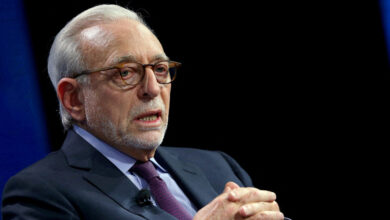Fixing Social Security Is an Election Issue Nobody Talks About

Millions of Americans worry about Social Security — whether they will get the full retirement paychecks promised to them in years to come. And many younger people believe — incorrectly, in my view — that by the time they are ready to retire, Social Security will no longer be there for them.
The issue is deemed so thorny in Washington that most politicians dance gingerly around it. The latest annual Social Security Trust Funds report in May said that unless action was taken, benefit cuts of roughly 20 percent would have to start in 2033.
Yet when you stop and really look at the problem, it turns out that what’s required for fixing Social Security is no big deal.
This isn’t a bold claim. It’s based on hard numbers calculated by Alicia Munnell, a Boston College economics professor who is among the nation’s premier experts on Social Security.
An increase in the 12.4 percent Social Security payroll tax of 3.5 percentage points — half borne by employers and half by employees — is all that’s needed to keep full Social Security benefits flowing in the 2030s and beyond, Professor Munnell explained in a telephone conversation.
She also stressed that even if Congress did nothing at all to fix Social Security, you would still get most of your promised benefits. That’s because most of the money financing Social Security checks comes from the payroll taxes being paid regularly by working people. Income from the system’s trust funds, which are dwindling, supplements it. Enough money will be going into the system from taxes to pay about 80 percent of benefits even if the trust funds run down to zero. But Professor Munnell doesn’t expect that to happen.
Why a Fix Is Coming, Eventually
The benefits for people who are already retired — or about to be — aren’t likely to be cut, because older people vote in large numbers. Taking away money that they have been promised would be political dynamite, as President Ronald Reagan discovered in the 1980s when his administration favored such a move, only to rapidly backpedal.
At some point, the political class will find a way to avoid that calamity. Millions of people already feel distress and confusion about retirement. It would be a lot better for everyone if the repair job happened sooner rather than later. Because of deficiencies in the rest of the nation’s retirement system, preserving Social Security benefits — not trimming them — is critical for the well-being of current and future retirees, Professor Munnell said.
Nonetheless, a tax increase for Social Security will never be a popular move. It isn’t even being discussed openly by presidential candidates, though both the Biden and Trump campaigns say they are committed to keeping Social Security intact.
In an election year, candidates aren’t rushing to solve a problem that won’t hurt people financially until the next decade and that will involve a tax increase, even only a fairly small one.
“It’s going to be a hard thing to do because you have to raise people’s taxes before they will see anything concrete,” Professor Munnell said. “You have to raise their taxes so they can get what they already think they should be getting. And so I do worry that, politically, in this country, we tend to go right up to the abyss and only act after we’ve reached it. That’s what we did in 1983,” when Social Security last received a major overhaul.
Numbers, Big and Small
Professor Munnell, 81, has been doing serious research on Social Security since the 1960s. As assistant secretary of the Treasury for policy issues from 1993 to 1995, she dealt with Social Security on an official basis. She has headed the Center for Retirement Research at Boston College since its founding 26 years ago, producing her own lucid annual reports on the state of the Social Security Trust Funds, soon after the Social Security trustees issue theirs.
While she’s immersed in the complexities of Social Security, she takes a common-sense approach and comes up with easy-to-understand answers.
How big of a problem is the Social Security funding gap? It can look large or small, depending on how you frame the numbers.
If you want to scare people, she said, point to the total estimated size of the gap between costs and income over the next 75 years: $22.6 trillion. That’s big!
But the U.S. economy is huge and growing. As a fraction of the entire economy over the next 75 years, the Social Security funding gap is tiny: just 1.2 percent of gross domestic product.
The crucial factor to keep your eye on is the payroll tax, since it provides the bulk of Social Security’s funding. As a fraction of the total amount of money collected through the payroll tax, the funding gap is about 3.5 percent.
That’s why Professor Munnell recommends an additional 3.5 percentage points of payroll tax, which would be paid on top of the 6.2 percent that employers and employees are each responsible for now. (The self-employed pay the whole 12.4 percent tax themselves.)
Raise taxes just that much without changing anything else, she said, and much of the problem is gone.
Roots of the Problem
People in my generation, the baby boomers, are retiring in droves. At the same time, because of a long-term decline in the fertility rate, comparatively few people of working age are paying taxes to keep the system fully funded. Immigration has helped bolster the work force, and much more immigration would solve the problem, but given American politics, it wouldn’t be prudent to count on that.
These demographic issues were well understood in 1983, during the Reagan administration. That’s when a bipartisan commission led by Alan Greenspan, the future Federal Reserve chair, came up with the rudiments of a legislative package that put the system on a firm financial footing for a while.
Congress and the president ultimately agreed on a few key changes. They included increasing payroll taxes to their current rate, cutting benefits in subtle ways and building a surplus in the trust funds, which have fluctuated in size since Social Security’s founding in 1935. The idea was that when the baby boom generation retired and more money flowed out of Social Security than came in every year, the trust funds would make up the difference.
In congressional testimony last year, Stephen C. Goss, chief actuary for the Social Security Administration, said that in 1983 officials expected the trust funds to last until the mid-2050s. “It was known that further action would be needed by that time,” he said.
Instead, the day of reckoning is coming roughly 20 years earlier.
Two things went wrong, Mr. Goss said. The first was the deep recession of 2007-9, which threw off the long-term projections.
Second, and more important, is that income inequality in the United States rose far more rapidly than economists expected. Earnings for the top 6 percent “rose much faster than the overall average,” Mr. Goss said. In 1983, the Social Security payroll tax was imposed on 90 percent of the country’s wage income. Now, with taxable wages capped at $168,600, only about 82.5 percent of the nation’s wage income is taxed for Social Security, he said. The cap would need to be raised above $300,000 to get us back to the 90 percent coverage of the Reagan administration.
Raising the cap that way — taxing affluent people more and everyone else less — would reduce the 3.5-point tax increase needed to fully fund Social Security to as little as 2.45 points, the Social Security system estimated.
Many Options
Professor Munnell’s fix is simple and straightforward. She would add an automatic circuit breaker — which might temporarily freeze cost-of-living adjustments or tweak taxes or benefits — to prevent the system’s finances from ever getting way out of whack again.
Her proposals make sense to me, though I’d take the increase in income inequality into account, raise the wage cap and reduce the general payroll tax increase. That’s hardly a radical idea. It would be a return to the bipartisan spirit of Social Security reform endorsed by President Reagan, a famously conservative Republican, along with Speaker Thomas P. (Tip) O’Neill Jr., the Massachusetts Democrat.
There are infinite ways of fixing the system, and once an earnest effort is underway, many will be discussed.
Cutting benefits, though, ought to be ruled out, Professor Munnell said. Only about half the workers in the United States are covered by any retirement plan aside from Social Security. Even for those covered by workplace retirement plans, the overall picture of retirement readiness isn’t pretty. The financial services industry is more than willing to step in with solutions, but always for a fee.
The reality is that for most people, Social Security is as important now as it was 40 or 50 years ago.
The White House and Congress can wait until the 2030s, when benefit cuts will be imminent and general anxiety about retirement will be soaring.
Yet there’s no doubt at all that millions of people would be better off if Social Security was fixed, and benefits were assured, and it happened right now.



